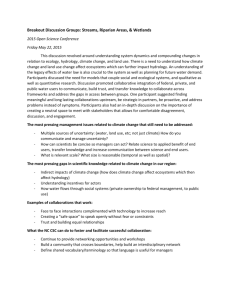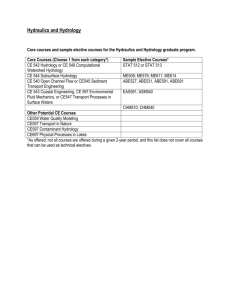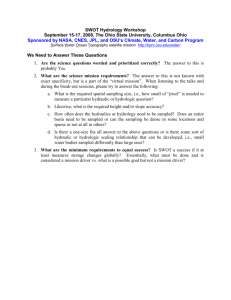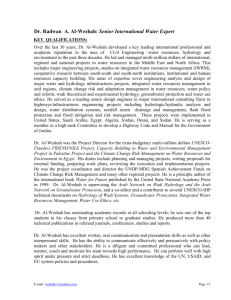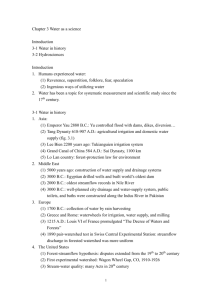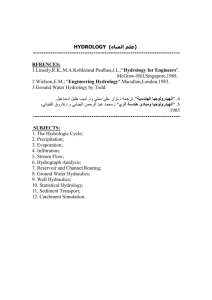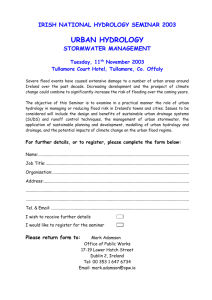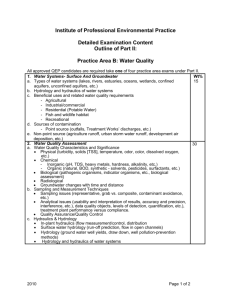Inaugural Meeting of the WATER HM Science Working Group
advertisement
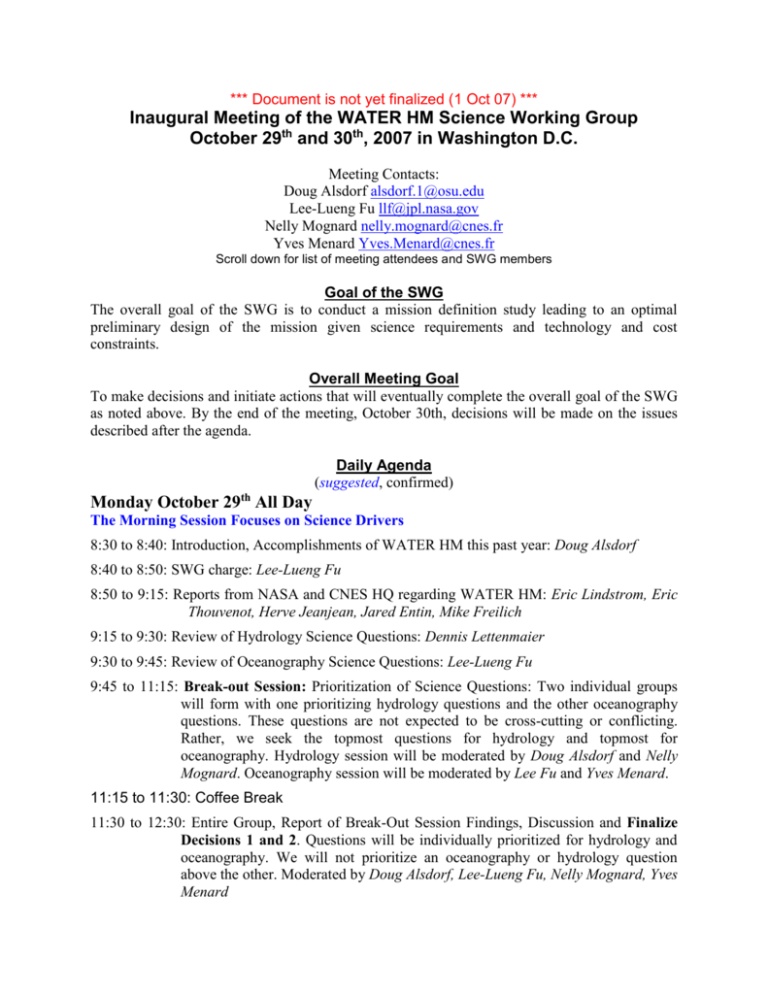
*** Document is not yet finalized (1 Oct 07) *** Inaugural Meeting of the WATER HM Science Working Group October 29th and 30th, 2007 in Washington D.C. Meeting Contacts: Doug Alsdorf alsdorf.1@osu.edu Lee-Lueng Fu llf@jpl.nasa.gov Nelly Mognard nelly.mognard@cnes.fr Yves Menard Yves.Menard@cnes.fr Scroll down for list of meeting attendees and SWG members Goal of the SWG The overall goal of the SWG is to conduct a mission definition study leading to an optimal preliminary design of the mission given science requirements and technology and cost constraints. Overall Meeting Goal To make decisions and initiate actions that will eventually complete the overall goal of the SWG as noted above. By the end of the meeting, October 30th, decisions will be made on the issues described after the agenda. Daily Agenda (suggested, confirmed) Monday October 29th All Day The Morning Session Focuses on Science Drivers 8:30 to 8:40: Introduction, Accomplishments of WATER HM this past year: Doug Alsdorf 8:40 to 8:50: SWG charge: Lee-Lueng Fu 8:50 to 9:15: Reports from NASA and CNES HQ regarding WATER HM: Eric Lindstrom, Eric Thouvenot, Herve Jeanjean, Jared Entin, Mike Freilich 9:15 to 9:30: Review of Hydrology Science Questions: Dennis Lettenmaier 9:30 to 9:45: Review of Oceanography Science Questions: Lee-Lueng Fu 9:45 to 11:15: Break-out Session: Prioritization of Science Questions: Two individual groups will form with one prioritizing hydrology questions and the other oceanography questions. These questions are not expected to be cross-cutting or conflicting. Rather, we seek the topmost questions for hydrology and topmost for oceanography. Hydrology session will be moderated by Doug Alsdorf and Nelly Mognard. Oceanography session will be moderated by Lee Fu and Yves Menard. 11:15 to 11:30: Coffee Break 11:30 to 12:30: Entire Group, Report of Break-Out Session Findings, Discussion and Finalize Decisions 1 and 2. Questions will be individually prioritized for hydrology and oceanography. We will not prioritize an oceanography or hydrology question above the other. Moderated by Doug Alsdorf, Lee-Lueng Fu, Nelly Mognard, Yves Menard 12:30 to 1:30: Lunch The Afternoon Session Focuses on Science Linkages to Mission Design & Technology 1:30 to 1:40: Introduction to Risk Reduction Issues: Doug Alsdorf, Issues include (1) spacecraft power and orbit, (2) hydrology virtual missions identifying needed spatial and temporal resolutions, (3) radiometer accuracies over coastal and land surfaces and alternative strategies, (4) field results of Ka-band radar over rivers, (5) mitigation of rain rates, and (6) any others 1:40 to 2:10: Hydrology virtual mission: Dennis Lettenmaier 2:10 to 3:45: Spacecraft Power and Orbit, 15 minute presentations by Tidal aliasing issues: Richard Ray Tidal aliasing issues: Florent Lyard Current orbit design: Steve Nerem Existing spacecraft: Bruno Lazard JPL studies: Ernesto Rodriguez 3:45 to 4:00: Coffee Break 4:00 to 5:00: Water vapor corrections and radiometer issues: 15 minute presentations by Issues with coastal zones: Ted Strub Options with various radiometers: Shannon Brown CLS perspective on radiometers: CLS Person 5:00 to 5:15: First day meeting wrap-up: Doug Alsdorf Tuesday October 30th Morning Only 8:30 to 8:50: Field results of Ka-band radar over rivers: Delwyn Moller 8:50 to 9:15: Ka-band radar studies, CNES Pre-Phase A work: Bruno Cugny 9:15 to 10:15: Entire Group, Discussion and Finalize Decisions 3 and 4: issues of rain rates and Ka-band vs. Ku-band will be raised. Moderated by Doug Alsdorf, Lee-Lueng Fu, Nelly Mognard, Yves Menard 10:15 to 10:30: Coffee Break Remainder of the Morning Session Focuses on Naming Team Leaders and Action Items 10:30 to 11:00: Timeline for completion of SWG Goal and related report: Lee-Lueng Fu, Discussion will focus on report content, assignments, and schedules. Decision 5 will be finalized. 11:00 to 11:30: Mission timelines and funding availability: Eric Lindstrom, Eric Thouvenot, Herve Jeanjean, Jared Entin, Randy Freidl, Discussion will focus on a potential schedule that includes submission of SWG report in 2008, pre-project planning in 2009, and project start in 2010. NASA HQ and CNES will need to comment on the reality of this scenario and corresponding funding issues. Decision 6 will be finalized. 11:30 to 12:00: Open Forum: What are the issues on the horizon? How will we handle the massive data volume from WATER HM? To what degree and how should the SWG connect with society and policy? Should we engage international agencies? To what degree and how should the SWG connect with operational applications/operational agencies? Moderated by: Doug Alsdorf, Lee-Lueng Fu, Nelly Mognard, Yves Menard 12:00 to 12:15: Meeting wrap-up: Doug Alsdorf Decisions to be Made During Meeting Decision 1: Define the science questions The overall science agenda for WATER HM includes physical oceanography and hydrology. We need to ensure that our science goals can be answered by the spatial and temporal resolutions and the height and slope accuracies of the KaRIN instrument. Specific science questions tied with the technology studies (below) need to be finalized. Potential other science targets (bathymetry, land topography, etc.) should be identified, but only those that avoid science and technology creep. Decision 2: Prioritize the science questions The science drivers should be prioritized in terms of ″critical and must have″ (e.g., determination of storage changes in lakes and reservoirs) to those of less importance but still valuable (e.g., land surface topography). This prioritization should focus the mission and prohibit science, technology, and cost creeps. Decision 3: Identify linkages between science and technology issues Our science questions need to drive the technology. For example, oceanographic science questions define the need for certain orbits whereas hydrologic science requires high-spatial resolutions to sample rivers with smaller widths (less than 100m). This sampling may require a certain amount of power to ensure a signal-to-noise ratio capable of supplying the needed height accuracies. Power requirements are a function of the orbit. CNES developed initial studies necessary for submitting the WatER proposal to ESA whereas JPL has a large investment in WSOA related studies. The SWG needs to update these previous studies by ensuring that the hydrology and oceanographic science drivers are within a reasonable budget (i.e., develop cost trade-offs). Some studies have already been conducted or are in progress. For example, field experiments showing Ka-band radar returns from rivers, data assimilation to determine river discharge, and assessments of SRTM for estimating discharge have already been conducted. A hydrology virtual mission study is now fully funded by NASA and will provide trade-offs between various sampling strategies and the derived discharge and storage changes. Decision 4: Prioritize risk reduction studies Various studies have been discussed such as a need to update the CNES WatER power consumption study which focused on sun-synchronous orbits with stationary solar panels instead of a non-sun-synchronous orbit with solar panels rotating once per orbit (or other configurations). Such studies recognize that the oceanographic community at the Hobart OST meeting endorsed non-sun-synchronous orbits. Additional needed studies will include the usage of DEMs to mitigate spacecraft roll errors and to correct errors from atmospheric water vapor; determining the power necessary to meet the required height accuracies; the degree to which rain rates are mitigated; height accuracy over small rivers; etc. Prioritizing the needed studies and securing their funding are functions of the SWG. Decision 5: Name individuals to lead tasks and resolve related issues People in the SWG were selected for their expertise related to the issues outlines in Decisions 1-4 and detailed below. We expect that individuals from the SWG will lead the risk reduction studies and provide final reports upon conclusion of the studies. A key aspect of leading a risk-reduction team is to ensure that the optimal number of researchers are immediately available to conduct the work. Decision 6: Timeline A timeline is needed to ensure that the mission makes steady forward progress and so that CNES and NASA can make plans for funding key activities. A job of the SWG is to ensure timely funding for these trade-off studies. Action Item 1: Ensure funding sources Post-meeting actions will immediately focus on securing funds for the highest priority riskreduction studies. NASA, JPL, and CNES have all indicated willingness to engage in funding key studies. Action Item 2: Communicate with team leaders We need to develop a routine of regular interaction with risk-reduction teams. Telecoms will be used as well as the WATER HM web page (http://earthsciences.osu.edu/water/) for archiving preliminary and final study results, providing links to risk-reduction models, Action Item 3: Continue to develop the joint-science community A key aspect of the SWG is to ensure that the global community of oceanographers and hydrologists recognize the importance of bringing together our two communities. This will likely require regular WATER HM presentations at international and specialized meetings, occasional open meetings hosted by the SWG, publication of results, and interactions with key leaders at CNES and NASA HQ (and perhaps other Federal and National agencies?). Details of Agenda: I. Decisions 1 and 2 focus on science questions: The suggested top priority hydrology question is focused on the terrestrial surface water contribution to the global water cycle. The suggested top priority oceanography question is focused on the dynamics of kinetic energy in ocean currents. The prioritization of all WATER HM science questions is a task for the entire SWG. Additional hydrology science questions under consideration include those related to flood hazards, water resource management, carbon evasion, and health issues. Additional oceanographic science questions include those related to coastal zones, contributions to climate data records, improving hurricane forecasts, and operational needs like those related to transportation, pollution, and wasted disposal. These questions need careful articulation. For example, saying that WATER HM will answer the question of ″how much surface water is on the Earth″ is not exactly true. Rather, WATER HM will address the question of ″what is the spatial and temporal variability of terrestrial surface waters around the globe″. Questions related to sea level also need clarification because WATER HM may not be explicitly designed to address the question of ″what is the rate of sea level rise″. Rather, WATER HM will make high-resolution measurements of ocean surface topography and issues related to the mean sea surface. Oceanographic questions will need to carefully consider internal tides, which operate at ~100 km spatial scales and external tides, which are ~1000 km scales. Internal tides are a function of the thermocline and operate on spatial scales similar to meso-scale currents, thus they can be a source of error. Both internal and external tides are a source of error via aliasing. All questions need to be refined so that the height and spatial accuracies required for answering the question are cost effective (see next section). For example, hydrology is proceeding with a NASA funded study, the Virtual Mission, which will define the accuracy trade-offs associated with coarse vs. fine samplings and how effective these are for constraining the global terrestrial water cycle, improving flood hydraulics, and the other hydrology questions. A key consideration for all questions is the design lifetime of the satellite mission. Costs increase markedly for longer mission lifecycles, e.g., 3 years compared to 5 years. Thus questions should be focused on those that can be answered in a minimal amount of time. There is a certain degree of ″excitement″ that needs to be enveloped by the science questions. For example, measuring vector winds does not engage the general public, whereas the entire world is keenly interested in hurricanes. Similarly, floods have a tremendous economic impact, especially in developing countries. While WATER HM is not a flood chasing satellite, it should provide new insights toward understanding how floods evolve. Applications of WATER HM measurements are important, but we should view WATER HM as a demonstrator of science. Essentially, the science questions will need to have some degree of direct applicability while focusing on unanswered science questions of great impact. We also welcome other science questions, particularly those related to ocean bathymetry and sea ice. Synergies with these questions need to be developed so that new science questions do not lead to costly technology creep. For example, if the optimal WATER HM orbit configuration does not extend well into Arctic ocean, then is the additional cost to cover the ice pack too prohibitive? Modeling is increasingly important for understanding the global water cycle and oceanic circulation issues. Satellite measurements are never sufficiently frequent enough to measure the full dynamics of water movement (e.g., every second), however the spatial density of wide-swath samples allows a high-resolution and broad-scale application in modeling. We need to determine the requirements of models and ensure that our colleagues from the various hydrologic, ocean circulation and climate modeling communities are involved in WATER HM planning and its eventual measurements. In summary, hydrology science questions to be directly addressed by WATER HM are at the zero-order level, i.e., highly important and with immediate impact. The great achievements resulting from Topex/Poseidon and its successors allow oceanography to ask higher-order questions on the kinetic energy of the ocean that is of great importance to both climate science and practical applications. II. Decisions 3 and 4 focus on trade studies Discussions will focus on the various activities that are designed to address the trade-offs between science questions, technology required to address the questions, and the involved costs. Hydrology is conducting a series of ″Virtual Mission″ (VM) studies which include data assimilation. A VM consists of a water balance model which supplies rainfall generated runoff at a coarse grid scale (e.g., 0.5 degree) to a fine-scale (~100 m) hydrodynamic model which routes water through a channel and across a floodplain. The routing results in water surfaces which are then sampled with an instrument simulator designed with various error characteristics (e.g., layover, thermal noise, etc.). These measurements represent the KaRIN instrument and are subsequently used in a data assimilation scheme designed to assess the importance of the errors in constraining discharge estimates and storage change measurements. Published first-results are promising and represent a new avenue for working with spaceborne surface water measurements. Hydrology is also using SRTM elevation measurements as a proxy for KaRIN. Although SRTM is at least an order of magnitude lower in accuracy than the design of KaRIN, published first-results using a simple Mannings n approach suggest that SRTM is capable of supplying discharge estimates from large rivers such as the Amazon, Ohio, and Missouri. Ka-band radar has now been tested from several bridges over terrestrial water bodies. A reservoir and two rivers in Ohio were chosen as targets representing surface water characteristics of wind advected wave action across a standing body of water and different turbulent conditions for moderate and large rivers (i.e., the Muskingum River at ~300 m3/s and Ohio River at ~3000 m3/s). Results demonstrate that Ka-band will provide significant backscatter energy at the look-angles proposed for KaRIN, including angles beyond 6 degrees off-nadir. As a general characterization of all surface conditions, the change in dB is only ~10 dB or less from peak at nadir to the returns registered at 6 degrees off-nadir. Radiometer studies are needed that will characterize height errors related to atmospheric water vapor over coastal and terrestrial areas. Both CNES and JPL have made preliminary studies with somewhat similar conclusions. Options suggest a large antenna to acquire sufficient km-scale resolutions or a smaller, multi-frequency antenna. This Fall, a coastal altimetry workshop is being held and it is suggested that WATER HM be represented at this meeting to further our collaborations with this important community. CNES is advancing their previous studies which were based on WSOA and the WatER concept (a sun-synchronous orbit with the KaRIN wide-swath instrument and the AltiKa nadir altimeter). CNES is now conducting a Phase Zero study to investigate the power requirements and fit with the Pleiades platform (i.e., the PASO study). This would be an upgrade from the WatER design using the PRIMA platform. Initial power studies suggest that solar panels on a non-sun-synchronous platform would require 21 square-meters for 1000 watts and 33 sq-m for 1600 watts. These studies need to verify the number of articulation points used in the design of the solar panels. The new generation of platforms may not accommodate such large solar panel arrays, thus it is suggested to decrease the solar panel sizes, hence decrease the power requirements. The SWG will need to determine if it is acceptable to decrease the power requirements, hence decrease the height accuracy of KaRINs measurements. A broader scope of spacecraft study involving US aerospace industries should be conducted to fully evaluate the options for flying the mission in a nonsun-synchronous orbit to meet the oceanographic objectives. CNES has developed a tool capable of simulating multi-mission configurations (e.g., WATER HM and Jason) and the related orbit and tidal aliasing issues. The tool is designed to understand how variance can be reduced through multiple altimeters. CNES is also working on an intriguing idea of using the ONERA powered glider toward understanding Ka-band radar and interferometric altimetry. This work is in the planning stage and is not yet implemented. In summary, its clear that key studies are being advanced at JPL, CNES, and various universities, principally OSU and UW. The SWG will facilitate the organization and cooperation of these studies, especially as WATER HM heads toward implementation of Phase A. A key issue is to integrate these studies so that spatial, temporal, and height accuracies implied by the science studies are fit into the technology studies to determine related costs. The WATER HM Science Working Group includes these participants Name Aaron Boone Anny Cazenave Dennis Lettenmaier Detlef Stammer Doug Alsdorf Dudley Chelton Ernesto Rodriguez Florent Lyard Gregg Jacobs Jacques Verron Lee-Lueng Fu Nelly Mognard Paul Bates Pierre-Yves Le Traon Richard Ray Rosemary Morrow Yi Chao HOGC H HO H O H O OG O OC O O H H O OG O C Specialty modeling global water cycle sea level rise, surface water global water cycle global ocean modeling/assimilation remote sensing hydrology ocean eddies and altimetry sampling ocean winds, radar engineering ocean tides modeling, orbits US Navy oceanography/applications ocean modelling assimilation altimetry hydrology surface water hydrodynamics Oceanography/applications ocean tides and satellite orbit ocean eddies and altimetry sampling coastal ocean modeling/assimilation Agency MeteoFrance LEGOS-CNES UW U. Hamburg Ohio State Univ. Oregon St. Univ. JPL CNES-LEGOS NRL INPG JPL LEGOS-CNES Univ. Bristol IFREMER NASA Goddard CNES-LEGOS JPL Country France France USA Germany USA USA USA France USA France USA France UK France USA France USA Yves Menard O altimetry CNES-LEGOS France The WATER HM Science Working Group includes these headquarters people Name Eric Lindstrom Eric Thouvenot Herve Jeanjean Jared Entin HOGC O O H H Specialty Program Manager Oceanography Program Manager Oceanography Program Manager Hydrology Program Manager Hydrology Agency NASA HQ CNES CNES NASA HQ Note: HOGC refers to H = Hydrology, O = Oceanography, G = Geodetic Science, C = Coastal Zone List of Invited Meeting Attendees (as of: October 1, 2007) Name Aaron Boone Anny Cazenave Bruno Cugny Bruno Lazard C.K. Shum Delwyn Moller Dennis Lettenmaier Detlef Stammer Doug Alsdorf Dudley Chelton Eric Dombrowsky Eric Lindstrom Eric Thouvenot Eric Wood Ernesto Rodriguez Florent Lyard Gregg Jacobs Herve Jeanjean Jacques Verron Jared Entin Jay Famiglietti John Melack Kostas Andreadis Larry Smith Lee-Lueng Fu Mike Durand Mike Freilich Nelly Mognard Pascale Ultre-Guerard Paul Bates Will Attend Meeting Yes Yes Yes Yes Yes Yes Yes Yes Yes No Yes/No Yes Yes No Yes Yes Yes Yes No Yes No/Yes Yes Yes Yes Yes Yes Yes (likely) Yes No Yes Notes Monday Only Attend only Monday afternoon? Will try to change schedule Meeting is on his schedule Country USA FRANCE FRANCE USA Pierre-Yves Le Traon Pierre de May Randy Freidl Richard Ray Rosemary Morrow Shannon Brown Steve Nerem Ted Strub Yi Chao Yves Menard No Yes Yes Yes Yes/No Yes Yes Yes Yes Confirmed = 34 Cannot attend = 5 Need to hear from = 1 Potential Total = 35 Hotel Information: Marriott Residence Inn, located at 333 E St. SW, Washington D.C. 20024. Their phone is xxxxxx-xxxx (web: http://www.capitolmarriott.com/ ). Please note that we have reserved 24 rooms at the government per-diem rate of $201 per night. The hotel is across the street from NASA HQ. You will also note that it is a very short walk to the National Air & Space Museum as well as the many other museums and attractions on the ″Mall″. I believe all are free of charge to visit. Note that there are a couple of nearby Metro stations. L’Enfant Plaza station is a one-train ride from Reagan Washington National Airport (DCA) whereas a train-transfer is required to make it to the Federal Center SW station. From DCA airport to the hotel via the Metro: follow the signs inside the airport to the Metro station. Its outside of the airport and on an upper level. Take the Yellow Line toward Fort Totten. The fourth stop should be L’Enfant Plaza station. You can exit there and have nice walk to the airport or transfer trains to the Blue Line (head toward Largo Town Center) or to the Orange Line (head toward New Carrolton). Go one station and get off at Federal Center SW. From IAD (Dulles) airport to the hotel via the Metro: take the “Dulles Airport Bus” from the stop at Curb 2E. Board the “5A Bus” toward L’Enfant Plaza. I have never done this, but it should be straightforward. Click this link for a PDF with greater details. Link to Metro System: http://www.wmata.com/metrorail/systemmap.cfm Map of Hotel: or click this link for the full-size PDF

